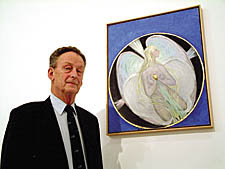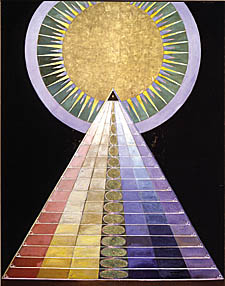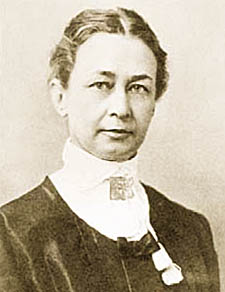|
|
 |
| |

Gustaf Klint with Human Chastity

Altar Painting

Hilma Klint |
A prophet and painter years ahead of
her time
Do artist Hilma Klint's paintings
contain coded messages that predict the future? asks Tom Foot
HILMA Klint described herself as an atom in the universe. But
the revelations surrounding a series of more than 1,000 paintings,
discovered 20 years after her death, has given the work of the
Swedish artist universal appeal.
Inspired by spiritualism and the occult, Klint produced exactly
1,000 paintings between 1906-27, which were later discovered
to follow a meticulous three-phase sequence and according to
Klint contain a mystical message.
Driven by her ‘leaders,’ voices in her head, her project
was kept secret for 50 years.
Critics ridiculed the exhibition when it opened in Stockholm
in 1966. Dismissed for decades after, Klint’s work has
gained increasing acceptance. Regarded as light-years ahead
of her time, she is seen as forerunner to the modernist movement
from Kandinsky to Mondrian.
An exhibition of Klint’s work at the Camden Arts Centre
exposes the fine line between madness and genius.
Following the death of her sister in 1880, Klint embarked on
a spiritual journey that provided a foundation for her work.
She was seen as a soothsayer and was called upon by desperate
patients deemed incurable by 19th-century doctors.
One painting depicts Britain surrounded by a swirling maelstrom
coming from the mouth of a man who resembles Adolf Hitler. It
was painted in 1930 as part of a later series of paintings not
discovered until the 1980s
Klint’s early work was stirred by the spirits summoned
during séances that she organised with a group of women
called The Five.
Her great-nephew, Gustaf, revealed the painter claimed she was
often possessed while painting.
He says: “In the first phase she was about 50-50 conscious.
Sometimes she would paint for hours and have no clue as to what
she had created. She was instructed by her ‘leaders’
at that stage. One was called Esther one was called Rob.”
Mr Klint – who has taken Hilma’s exhibition around
the world – told how Hilma’s leaders instructed her
to keep her project, which began in 1906, secret for 20 years
after her death.
As a result her work was not exhibited until 1966 – 22
years after her death.
The second phase of her work is in total contrast to the “automatic”
drawings from the séance phase. “It is unusual for
an artist to know what is on the inside as well as the outside,”
says Gustav.
As scholars began to study the third phase they found a meticulous
sequence to her paintings, complete with secret language and
a colour-coded hidden message apparently answering the philosophical
puzzler: what is the meaning of life?
Klint was inspired by religious ideals of compassion and later
the anthroposophical teachings of Rudolph Steiner. Anthroposophical
means becoming aware of one’s own humanity. Steiner, who
founded a worldwide society that has a branch and a theatre
in Marylebone, saw a lack of ideas in young people.
He believed this social downturn could not be remedied by political
or economic intervention and championed a spiritual alternative.
Klint’s final phase was influenced heavily by Steiner.
Gustav explains: “She saw a dualism in society, which is
reflected in her early work. Many of her paintings are split
in two. In the third phase, she believed life was about progressing
to a higher form.
She was obsessed by the way Adam and Eve were split up in Eden.
She saw life as a journey toward compassion that was achieved
by uniting with your other half.”
For Gustav, the final painting did not reflect Hilma’s
personal achievement of her goals but a path for others to follow.
He says: “When I first saw it I wanted to take it home.
Then when we took the exhibition to Australia a professor pointed
out to me that this was the crucial painting.
“The crown of the project – it represents the end
of dualism. It is incredibly powerful. It represents the path
to humanity, what life was all about for Hilma: reaching togetherness.”
|
|
 |
|



